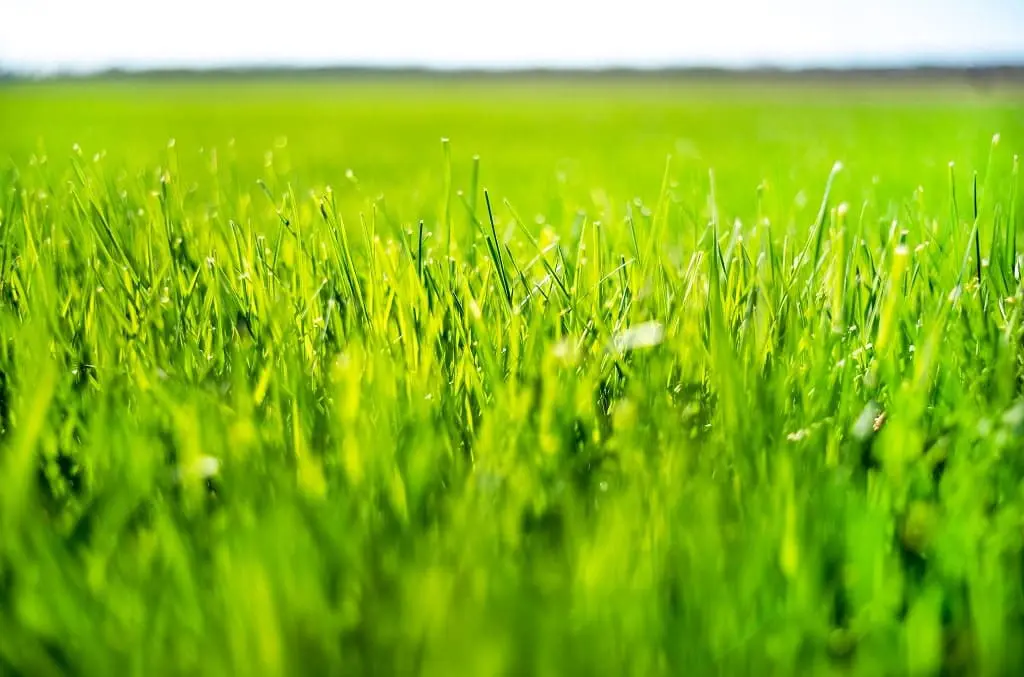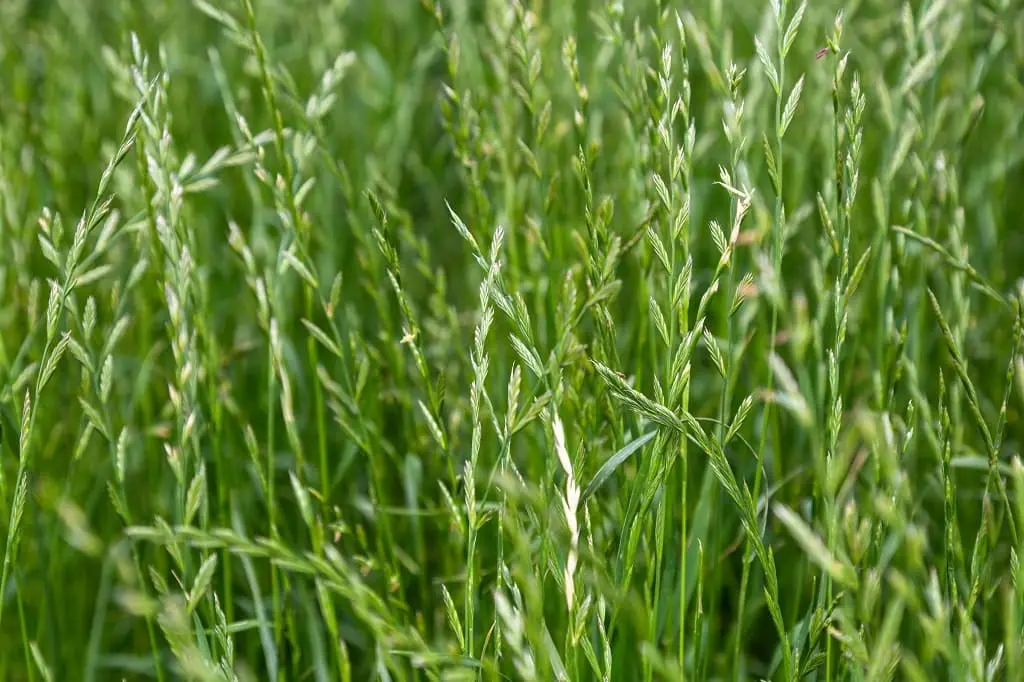If you’re in a state like Wisconsin or Minnesota and looking into lawn maintenance services during the cooler months, you should be aware of the most popular cool weather grass types. The best cool season grass can significantly enhance the look of your landscape when warm weather grass simply will not work.
In this article, we’ll look at the different types of cool season grasses, including Kentucky Bluegrass, Tall Fescue, Fine Fescue, and Perennial Ryegrass. Let’s dive in and look at each of these different types of cold weather grass.
Kentucky Bluegrass
Kentucky Bluegrass is a very popular cool season grass for a variety of reasons. Easily identifiable by a boat-shaped leaf tip, the bluegrass looks almost like the prow of a canoe. Dark green and somewhat narrow, it’s a beautiful grass that’s comfortable to walk on. But it may or may not be the best cool weather grass choice for your landscape. So before you make a decision on which cool weather grass to use, let’s take a look at the Kentucky Bluegrass pros and cons.
Pros of Kentucky Bluegrass:
- Kentucky bluegrass is widely adaptable and can be used in a lot of different situations.
- The grass grows dense and is soft on feet.
- It’s very durable and has an excellent ability to self-repair.
- It can survive cold temperatures.
- It recovers well from dormancy.
Cons of Kentucky Bluegrass:
- Kentucky bluegrass roots are shallow.
- The grass cannot survive in the shade.
- The grass germinates slowly. Kentucky bluegrass grows the most slowly out of all the grasses on this list.
- Kentucky bluegrass needs a fair amount of water to survive.
Despite these drawbacks, Earth Development knows Kentucky Bluegrass is well worth it due to its beautifully dense growth and rich color!
Tall Fescue

Tall Fescue may be the most popular of all the cool season turfgrasses because of how adaptable it is. The blades of Tall Fescue are medium-wide, exhibit uniform growth, and have dark shiny green leaves. There are several significant advantages to choosing Tall Fescue grass, especially if you’re in the Northern half of the USA where cool/humid temperatures tend to occur. Let’s go through the Tall Fescue Grass pros and cons:
Pros of Tall Fescue
- Tall Fescue looks great.
- Tall Fescue’s heat, drought, and shade resistance, making it very adaptable.
- Tall Fescue is very durable and resists wear and tear.
- Tall Fescue has a bunch-forming growth pattern, which makes it easier to keep out of garden beds.
- Tall Fescue has an extensive and deep root system.
Cons of Tall Fescue
- While drought is tolerant, Tall Fescue will be damaged if it doesn’t receive ample watering for over 100 days.
- In very hot and humid climates, Tall Fescue is susceptible to brown patch disease.
- Because of the bunch forming growth pattern, Tall Fescue has a limited ability to self-repair.
As you can see, Tall Fescue has very few drawbacks, and it’s no wonder it’s the most popular of the cool season grasses.
Fine Fescue
Fine Fescue has three main varieties, Red Fescue being the most popular. Best suited for dry and shady conditions, Fine Fescue is a relatively low-maintenance grass and is therefore preferable in certain circumstances. Rarely seen by itself, Fine Fescue is often used in combination with Kentucky Bluegrass and Perennial Ryegrass. Let’s go over the Fine Fescue grass pros and cons:
Pros of Fine Fescue
Fine Fescue Is Very Low Maintenance.
- Fine Fescue has very deep roots, which gives it great access to groundwater.
- Fine Fescue doesn’t grow that fast, reducing the need for constant mowing.
- Fine Fescue can grow in many different types of soil.
- Fine Fescue, while slow-growing, germinates rather quickly.
Cons of Fine Fescue
Fescue can be susceptible to pests and diseases.
If the soil doesn’t drain well, Fine Fescue can develop these types of diseases.
Fescue is not particularly soft underfoot, so it’s not ideal if you have a yard where kids are playing around a lot.
Perennial Ryegrass

Of all of the types of cold weather grasses, Perennial Ryegrass is some of the brightest and is easy to spot, even when blended with other grasses. Often thought to be a temporary grass, this Ryegrass comes back beautifully year after year. There is a lot to love about Perennial Ryegrass, as it is quite beautiful and has a fair amount of functional utility. Let’s dig into the pros and cons of Perennial Ryegrass:
Pros of Perennial Ryegrass
- Perennial Ryegrass germinates very quickly.
- Because it germinates much faster than other grasses, it can be a good nurse plant, providing shade to other grasses that take longer to grow.
- It has very high wear and tear tolerance, and can even survive low mowing quite well.
- Perennial Ryegrass is allelopathic, which means it can naturally suppress other plants from growing, such as crabgrass.
- It works great in blends with other grasses since it can withstand shade and maintain its color even in the winter months.
Cons of Perennial Ryegrass
- Perennial Ryegrass grows pretty thin, much thinner than Kentucky Bluegrass, for example.
- It does not survive extreme temperatures.
- The Perennial Ryegrass root system does not spread a long distance, so it has issues filling in bare patches.
Can I Mix Different Types of Cool-Season Grass?
Not only can you mix different types of cool season grass, but it’s also extremely common to do so! Blending several types of grass together makes them stronger, more durable, and more impressive than just one grass.
Each has different positive attributes, and combining them allows you to benefit from the best of each of them. For example, Perennial Ryegrass is a great nurse plant for Kentucky Bluegrass, and Kentucky Bluegrass helps to fill in bare spots that Perennial Ryegrass may suffer from.
Conclusion
Earth Development sure that it’s important to know the pros and cons of each of the most common cold weather grasses so you can understand the appropriate circumstances to use each. Better yet, understanding which combinations of grasses might suit your landscape the best can help you develop beautiful and durable landscapes during the cooler months.
If you’re looking for some guidance, it’s best to speak with the experts. For expert advice on the best cool weather grass for you and the best landscaping services throughout the Midwest, contact us at Earth Development.
